~*Happy New Year 2023*~
Thank you for using my blog!
~~*~~
(Source: https://www.isro.gov.in/icc-2020)
Drawing competition Rules
- The topic of competition will be sent on registered email and available on ISRO website on stipulated day.
- A3 size white paper or Chart paper should be used.
- Use water, wax or pencils colours for drawing.
- Write registration number in the top right corner of the drawing paper.
- Writing the participant name, school name etc. on the drawing paper shall make the participation invalid.
- The Participant / parent to take clear photograph or scan the drawing and upload it at the given link on ISRO website.
- Photograph in .pdf or .jpeg format only.
- Put name of file as registration number.
Syllabus for Drawing Competitions
- Viewing earth from space
- View of sky in clear night
- View inside space station
- Human landing on Mars
- Space Habitat on Moon
- Varying visible shapes of Moon
Click here to go ISRO ICC-2020 Link
- When are the competitions of ICC - 2020 organised?
- Drawing Competition (Class 1 - 3): 03/07/2020
- When and where the topic of Drawing Competitions will be displayed?
- The topic of Essay & Drawing Competitions will be displayed at 10:45 AM on the day of Competitions at the link for ICC-2020 on ISRO Web Portal only. Click here to go ISRO ICC-2020 webpage.
- Viewing earth from space
- When and in which format, the participants of Drawing Competition have to upload their answer sheet file?
- If you are participating in Drawing Competition, please upload clear photo of your drawing in .jpeg/.pdf format in between 11AM to 4 PM on 03/07/2020.
- Can I write my name, school’s name, phone number or any other personal details on Answer sheet?
- Please write Registration Number only at upper right corner of your Answer Sheet.
- Apart from this, do not write your name, school’s name, phone number or any other personal details at any page. This will lead to disqualification of your participation.
- Can I upload the submission second time?
- You can upload your file as many times as you want within the given time frame. The file uploaded by you during the last time, shall only be considered for evaluation.
- What is the maximum size of the file to be uploaded?
- The maximum size of your file to be uploaded is permitted up to 3.0 MB.
- Where can I upload the submissions for ICC-2020?
- You can upload your answer sheet by logging in at ICC-2020 link provided at ISRO Web Portal.
- Can I send my answer sheet for the competitions of ICC-2020 through e-Mail?
- No. Answer-sheets send by e-mail will not be considered for evaluations.
- How can I upload the submissions for ICC-2020?
- Log in at the link on ICC-2020 at ISRO Web Portal, as you have done it during the time of registration.
- I have forgot the password. What shall I do ?
- You can use ‘Forgot Password’ option given at bottom in login page and follow the instructions.
- What shall I ensure after taking the Photograph of Answer sheet?
- After taking the photograph of answer sheet, ensure that photograph taken by you is clear and legible or not. If photograph is blur and illegible than take clear and legible photograph again and upload it.
- Which App I can use for taking photograph / scan or converting the same in .pdf format?
- You can use any App, but you are requested to avoid using Mobile Apps banned by Ministry of Electronics and Information Technology of Government of India vide its Press Release dtd. 29th June 2020.
- Can I take help of my parents / siblings / friends / family members help for uploading?
- Yes, you can.
- I have uploaded my answer sheet successfully, what shall I do now?
- Congratulations! Wait for more update regarding date of results on ISRO Web Portal. Keep reading regularly about space missions, science and technology at ISRO portal.
- I still have some more doubts, whom shall I contact?
- You can e-mail us on icc-2020@isro.gov.in or call at 080-23515850 between 10AM to 5PM from Monday to Friday.
Step 1: Log in at the link on ICC-2020 at ISRO Web Portal, as you have done it during the time of registration.
You can upload your submissions at ISRO / ICC web portal by logging in.
Step 2: After Login, please upload the answer sheet by browsing on UPLOAD tab. After that, click on “Submit file” tab for submitting it.
Step 3: If you want to re-upload, then browse “RE-UPLOAD” tab for re-uploading.
Visit my Daughters YouTube Channel - Things We Love
Cute Greeting Card Using Watercolor Effect
My Preparation Guidelines
As per the notification from ISRO, the kids should use A3 paper for drawing in colors. ISRO will send subject of drawing on the day of competition on your registered email id. It is expected that subject will be one from the given syllabus. Therefore, it will be good idea to understand the syllabus and related information. Kids can practice drawing based on gathered information and be ready. In this section I am providing information on each subject.
Topic 1 - Viewing EARTH from space
Earth is a rocky, terrestrial planet. It has a solid and active surface with mountains, valleys, canyons, plains and so much more. Earth is special because it is an ocean planet. Water covers 70% of Earth's surface. Earth has just one Moon. It is the only planet to have just one moon. Earth is the third planet from the Sun in our solar system. That means Venus and Mars are Earth’s neighboring planets. (Source: https://spaceplace.nasa.gov/all-about-earth/en/)
Following images may help you to get an idea about how earth looks when viewed from space. You can explore more images on NASA and ISRO webpages. One can refer NASA's two free books:
- Earth - It is a photo-essay from NASA’s Earth Science Division. You may get lot of ideas from the satellite views of Earth and information given in this book. Download book by clicking here.
- Earth at Night - How humans and natural phenomena light up the darkness, and how and why scientists have observed Earth’s nightlights for more than four decades using both their own eyes and spaceborne instruments. Download book by clicking here.
(Source: NASA)
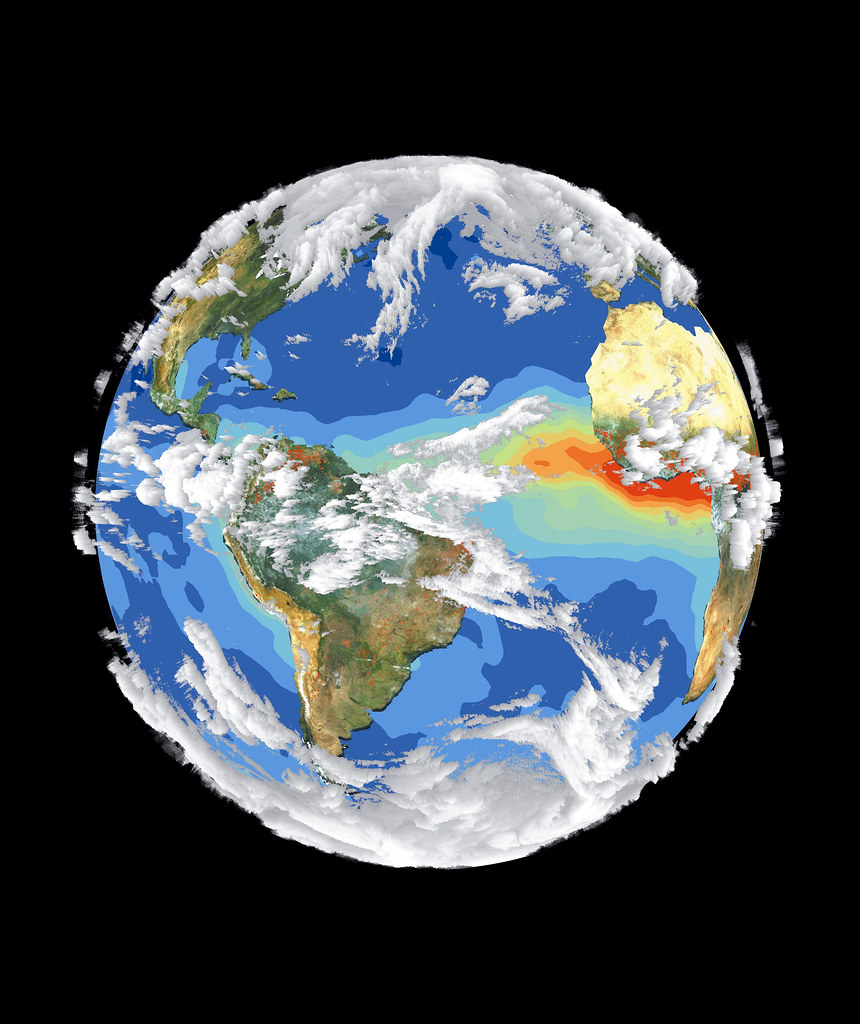
Climate condition Earth image captured by NASA

Earth and Moon Viewed from Space
When you view Earth from space, you may not see only Earth. You may see satellites. Earth has lots of spacecraft watching it. There are 4857 satellites currently orbiting the earth.
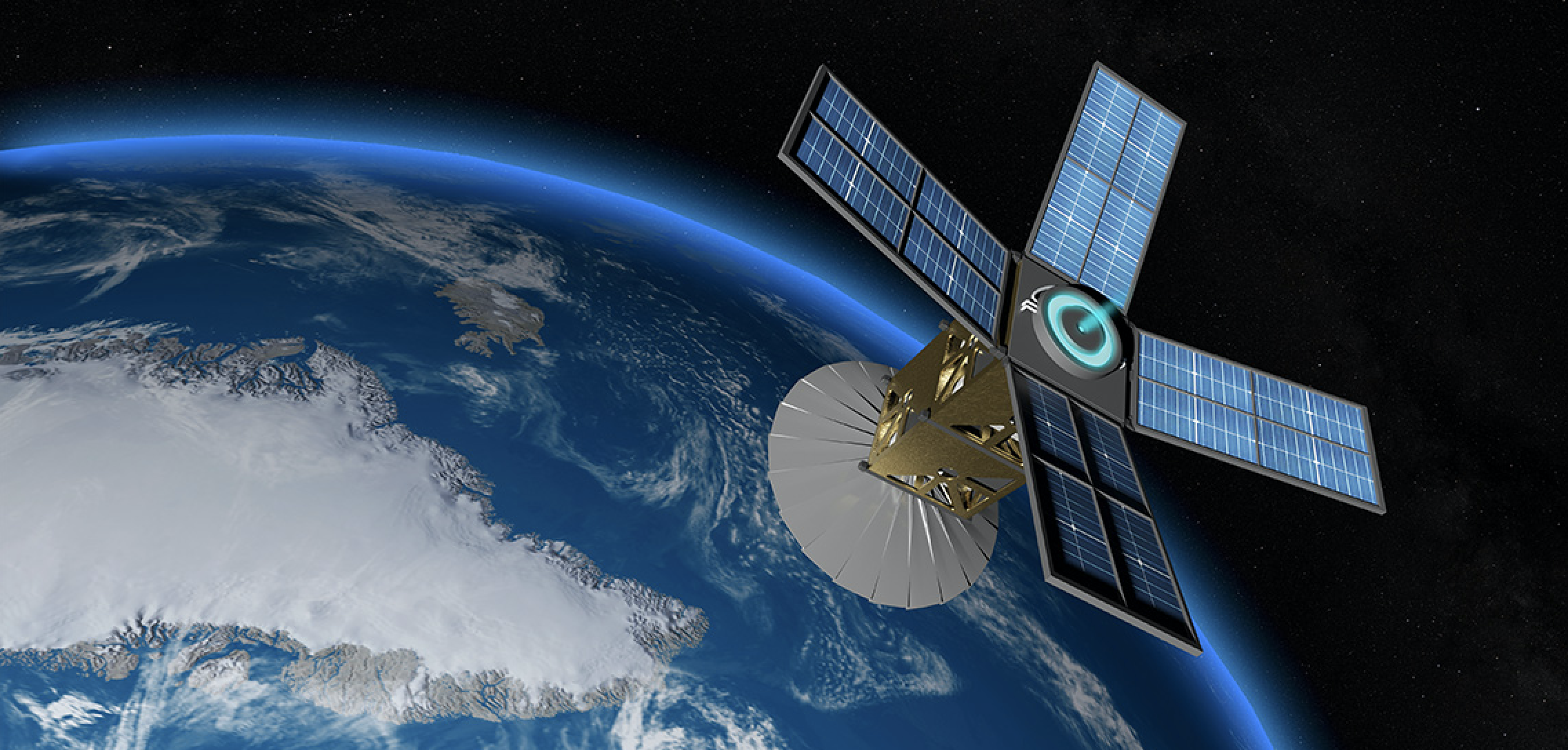
Earth with one satellite
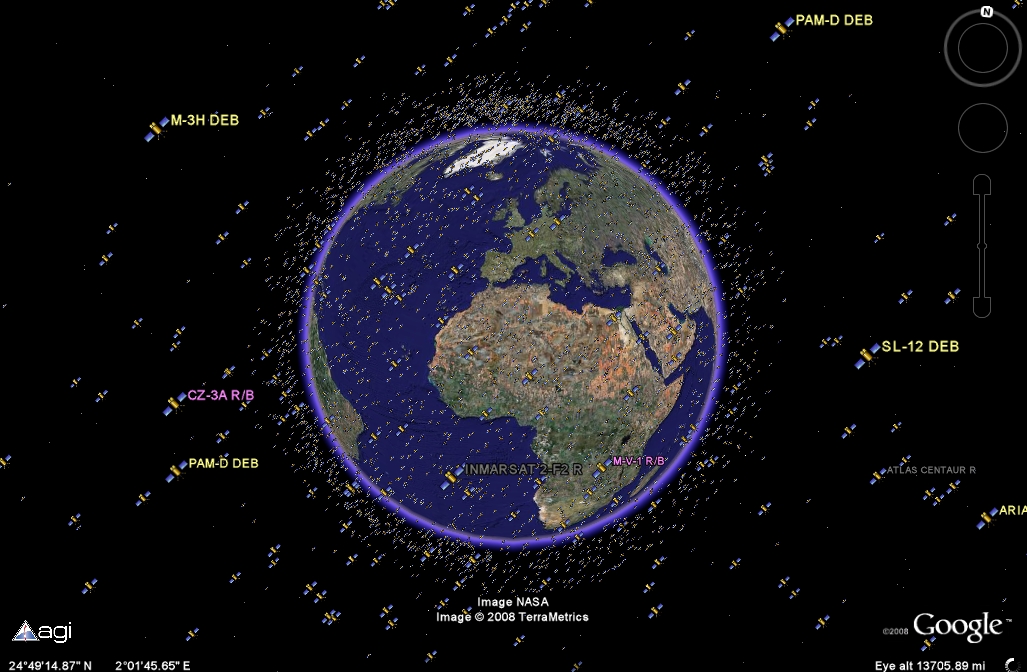
Earth with satellites and space debris.
Visit my Daughters YouTube Channel - Things We Love
Augmented Reality for Kids
Topic 2 - View of SKY in clear night
You are aware sky appears dark at night because that is when our side of Earth faces away from the Sun as our planet rotates on its axis every 24 hours. One may see different stars and constellations at night as shown below. You can read about stars and constellations in Chapter 17 of Class 8 Science Textbook Published by NCERT. Click here for the book.
Stars at in Sky at Night
Constellations in Sky at Night
The night sky may appear different through eyes, through telescope and through satellite. One can pick up theme and try creating drawing. Earlier BBC published 10 stunning images of night sky. Two sample images from each of the following two links are given here for your reference. You are encouraged to visit BBC links given below:
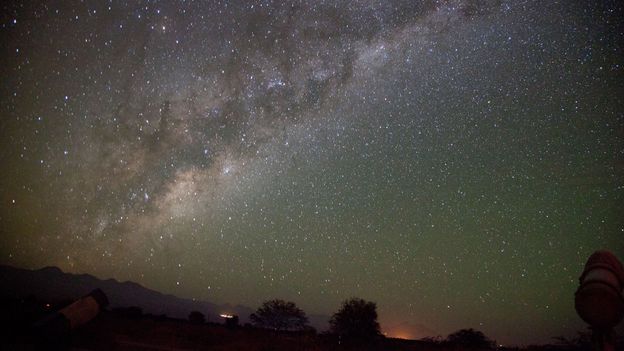
(Source: BBC - One of the picture from first link)
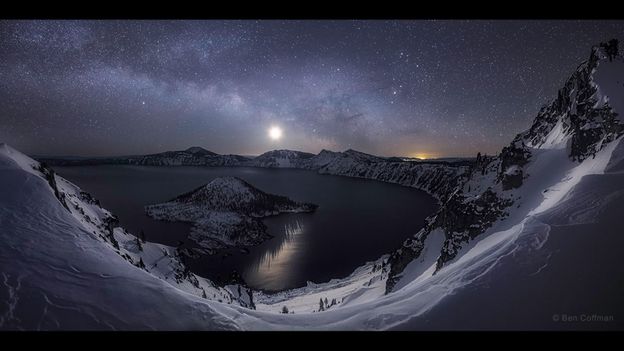
(Source: BBC - One of the picture from second link)
Visit my Daughters YouTube Channel - Things We Love
Create Yourself 3D Effects using Augmented Reality
Topic 3 - View inside SPACE STATION
A space station, also known as an orbital station or an orbital space station, is a spacecraft capable of supporting a human crew in orbit for an extended period of time that lacks major propulsion or landing systems. Stations must have docking ports to allow other spacecraft to dock to transfer crew and supplies. Following are some of the images inside space station from Google Earth.
Click here to visit the International Space Station (ISS) - Discover the ISS in Street View, captured in partnership with NASA, ESA, JAXA, Roscosmos and CASIS.
Visit my Daughters YouTube Channel - Things We Love
Create Your Own Magical Scratch Paper
Human Landing on MARS
A human mission to Mars has been the subject of science fiction, aerospace engineering and scientific proposals since the 20th century. Plans include landing on Mars for exploration at a minimum, with the possibility of sending settlers and terraforming the planet or exploring its moons Phobos and Deimos also considered. Some of the movies related to Mars mission are:
Some of the pictures depicting human landing on mars are as shown below:

(NASA concept for first humans on Mars, with a habitat and rover, 2019)

(Concept for Mars base with ice dome, pressurized rover, and Mars suits, 2016)

(Simulation of an astronaut on Mars)
(NASA YouTube Video - Humans to Mars)
Visit my Daughters YouTube Channel - Things We Love
Tissue Paper Magic
Space Habitat on MOON
No human has walked on the Moon since the Apollo 17 mission in December 1972. This time, though, the astronauts will stay much longer than the few days of the Apollo 17 mission. So now, NASA's Exploration Technology Development Program is working on everything that will be needed to make the Moon a place where a crew of astronauts can live for months.
Explorers from Earth will have to build their own habitat, or home. Their home must protect them like no home on Earth would ever need to do. Why?
There is no air on the Moon. And the temperature varies from 387 degrees Fahrenheit BELOW zero (-233 Celsius) at night to 253 degrees Fahrenheit ABOVE zero (123 Celsius) in the day. Tiny micro-meteoroids (space rocks) rain down on the Moon's surface. And no atmosphere means no protection from the Sun's harsh radiation.
So a Moon habitat for humans will have to be very tough and very sturdy. It will have to be air tight, so the inside can be pumped up with breathable air without exploding or leaking. The habitat will have to be cooled during the Moon day and heated during the Moon night. It will need a water recycling system, a power generating system, and food storage and preparation facilities.
The materials to build the Moon habitat should be lightweight, since they will have to be boosted out of Earth's gravitational field using rockets.The habitat will have to be sent to the Moon in pieces and assembled by the explorers once they arrive. So it should be easy to put together, since the Moon explorers will be working in space suits.
Moon habitat prototype in the lab.
NASA's Exploration Technology Development Program is working on designs for a Moon habitat. The light-weight experimental house shown here is inflatable, so would not take up much space until needed.
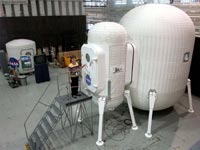
As with any Moon habitat, it must have an airlock. The airlock is a small room between the door to the outside and the door to the inside. Both doors must close very tight and not leak any air. Before the astronaut opens the outside door, the inside door must be closed. The astronaut enters the airlock and closes the outside door. Then the airlock is pumped full of air. Only then can the astronaut open the inside door to enter the habitat. Leaving the habitat, the astronaut (in a spacesuit, of course), steps into the airlock with the outside door closed. The inside door is then closed and all the air pumped out of the airlock, making it a vacuum, just like the outside. The astronaut opens the outside door and steps outside.
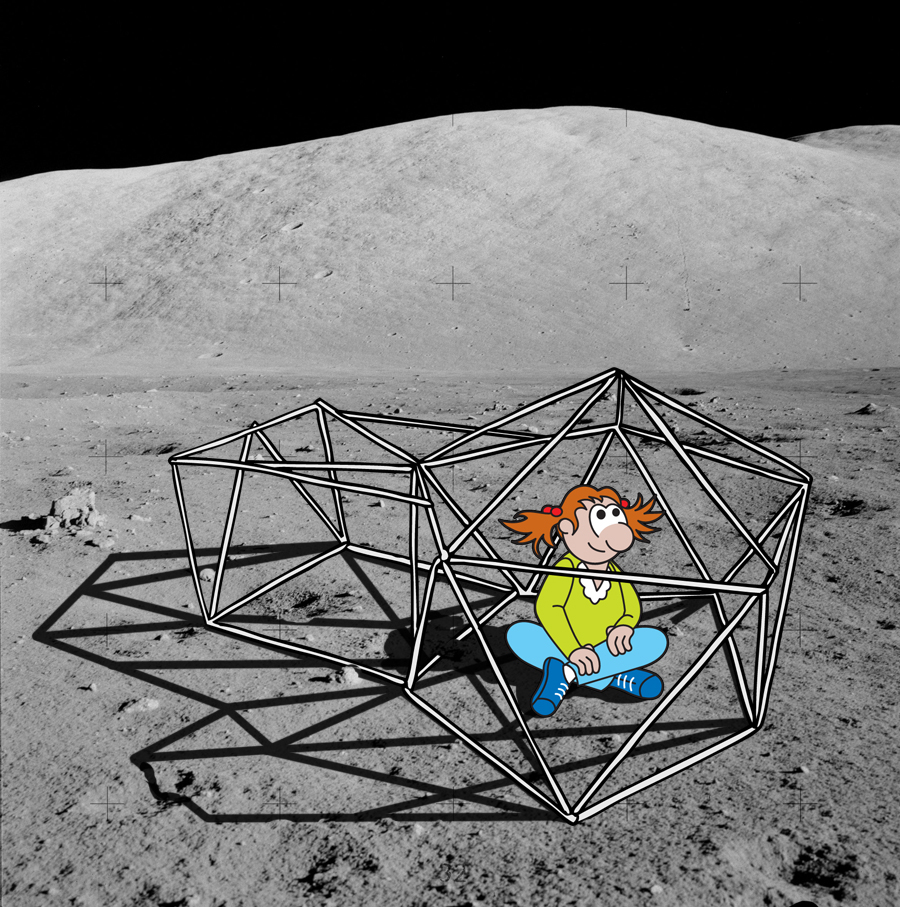
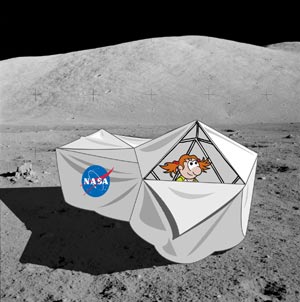
Habitat on the lunar surface, with cartoon girl sitting inside.
The Indian Space Research Organisation (ISRO) has carried out two successful missions to moon i.e.
Chandrayaan-1: 22 October 2008 - 28 August 2009
Chandrayaan-1 was India's first lunar probe. It was launched by the Indian Space Research Organisations in October 2008, and operated until August 2009. The mission included a lunar orbiter and an impactor. The mission was a major boost to India's space program, as India researched and developed its own technology in order to explore the Moon. The vehicle was successfully inserted into lunar orbit on 8 November 2008.

Chandrayaan-2: 22 July 2019
Chandrayaan-2 was launched from the second launch pad at Satish Dhawan Space Centre on 22 July 2019 at 2.43 PM IST (09:13 UTC) to the Moon by a Geosynchronous Satellite Launch Vehicle Mark III (GSLV Mk III). The planned orbit has a perigee of 169.7 km and an apogee of 45475 km. It consists of a lunar orbiter, lander and rover, all developed in India. The main scientific objective is to map the location and abundance of lunar water. Orbiter functional; the lander crashed onto Moon's surface due to loss of control during the final phase of descent.

Varying Visible Shapes of MOON
Our earth has only one satellite, that is, the moon. Its diametre is only one-quarter that of the earth. It appears so big because it is nearer to our planet than other celestial bodies. It is about 3,84,400 km away from us. Now you can compare the distance of the earth from the sun and that from the moon. The moon moves around the earth in about 27 days. It takes exactly the same time to complete one spin. As a result, only one side of the moon is visible to us on the earth. The moon does not have conditions favourable for life. It has mountains, plains and depressions on its surface. These cast shadows on the moon’s surface.
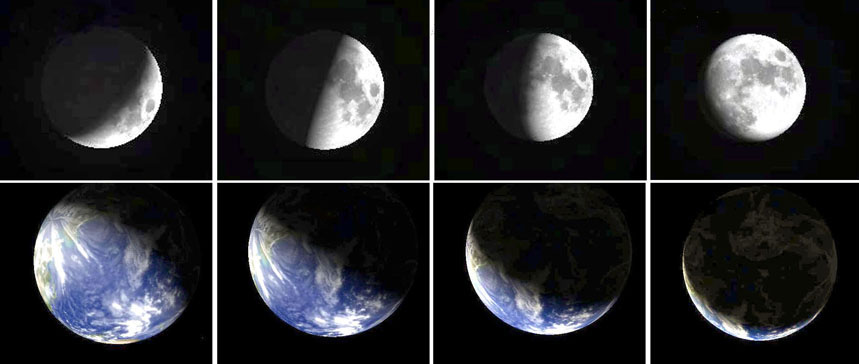

Some varying shapes of moon
Visit my Daughters YouTube Channel - Things We Love
Lifecycle of Butterfly and Augmented Reality
